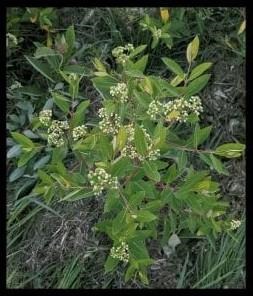Not only is hemp dogbane showing up a month earlier than typical this year, but it wasn’t even invited to the agricultural landscape party. But it is here already, and it needs swift attention in the midst of all the other tasks on our to-do lists. It is an aggressive perennial weed of no-till systems.

Having emerged early this year, dogbane will soon be in bloom.
Hemp dogbane has creeping roots; leaves that appear on opposite sides of the stem; and it produces a milky sap. It is often confused with milkweed, which is very similar in appearance before blooming and often found growing side by side. Differences include that young milkweed leaves have fine hairs and hemp dogbane leaves are nearly hairless; milkweed stems are generally thick and green, but hemp dogbane stems are usually red to purple and thinner in comparison; hemp dogbane frequently branches in the top canopy, while milkweed will typically not branch unless mowed; and seed pod shape is distinctly different after flowering with milkweed producing an upright tear drop shaped pod and hemp dogbane producing a long bean-like pod that hangs from the plant.
While the usefulness of milkweed in the landscape is often justified for monarch butterfly populations, hemp dogbane has fewer redeeming qualities. Historically hemp dogbane has been used by Native Americans to make rope, clothing, and baskets. Now, it is typically considered a weed in managed spaces. It has the capability to spread rapidly via creeping roots and seed production. It should be controlled in agricultural settings with a combination of strategic mowing and systemic herbicide application.
Hemp dogbane, and milkweed too, are considered poisonous to livestock. Toxicities can occur from fresh or dried leaves, stems, and roots. While death from poisoning is rare, reduced production efficiency is common if consumed. Symptoms range from mild to severe and include vomiting, diarrhea, coordination loss, tremors, heart problems, respiratory distress, and death.
According to the 2022 Ohio, Indiana, and Illinois Weed Control Guide, hemp dogbane is a significant agronomic weed in no-till systems. Various postemergence herbicides can be effective if the plants are less than eight inches tall. Judging by this year’s growth, many plants are already past a foot in growth. But there is still time to treat. For the best control of the creeping root system, applications of translocated herbicides should be applied when the plants are in the bud to flower stage, which could occur in the next couple weeks.
Attaining complete control after one herbicide application is unlikely. The most appropriate time to treat and product to use depends on the situation. Commonly used herbicides for suppression or control include glyphosate, 2,4-D, dicamba, and triclopyr products. Always follow the directions printed on the herbicide label for application rates, methods, and concerns.
Learn more about hemp dogbane by studying the photos included before and during flowering.
Before implementing any weed control program, getting an identification confirmation is very important! Study the whole plant before making a judgement call on how to address it’s presence.
Source : osu.edu